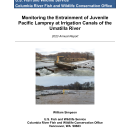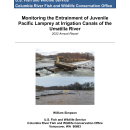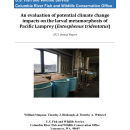
1211 SE Cardinal Court Suite 100
Vancouver, WA 98683
United States
About Will Simpson
Will supervises the Natural Population Assessment program. The program’s goal is to recover ESA-listed populations and prevent future listings by collaboratively anticipating and addressing knowledge gaps that are essential to assessing the status and trends of USFWS trust species, and to investigate scientifically-defensible ways for managers to mitigate any negative effects of anthropogenic change to native species and their habitats. Currently Will monitors ways that warming temperatures may affect lamprey, and the survival and movement of fish (lamprey and steelhead) that are diverted or screened at irrigation canals. He also represents USFWS on the PIT Tag Steering Committee, providing guidance on tag detection and data management for internal and external partners in the Columbia River basin.
Program: Natural Population Assessment
Current Projects:
1. Supervising the Natural Population Assessment program
2. Participating in the Columbia River basin’s Pit Tag Steering Committee as a representative of the USFWS
3. Providing expertise on PIT tag detection and data management for internal and external partner
4. Providing expertise on PIT tag detection and data management for internal and external partner
Past Projects:
1. The effectiveness of using tools (i.e., electricity) to control invasive or nuisance species and recover fish habitat, and how such tools may affect the survival and behavior of native fish.
2. Examining how hatchery salmonid supplementation influences naturally-reared fish.
3. Monitoring the movement and route of passage of outmigrating juvenile salmonids at large hydropower facilities.
Publications:
Simpson, WG. 2018. The entrainment and screening of returning and postspawning adult salmonids at irrigation canals of the Umatilla River, Oregon. Journal of Fish and Wildlife Management 9(1):285-295; e1944-687X
Simpson, WG, DP Peterson, K Steinke. 2016. Effect of waveform and voltage gradient on the survival of electroshocked steelhead embryos and larvae. North American Journal of Fisheries Management 36: 1149-1155.
Simpson, WG, KG Ostrand. 2012. Effects of entrainment and bypass at screened irrigation canals on juvenile steelhead. Transactions of the American Fisheries Society 141: 599-609.
Simpson, WG, BM Kennedy, KG Ostrand. 2009. Seasonal foraging and piscivory by sympatric wild and hatchery-reared steelhead from an integrated hatchery program. Environmental Biology of Fishes 86: 473-482.
Background: Will previously worked for the USGS Columbia River Research Laboratory. Prior to joining the CRFWCO, he worked at Abernathy Fish Technology Center (USFWS). Will earned his M.S. at Portland State University.
At CRFWCO Since: 2017




